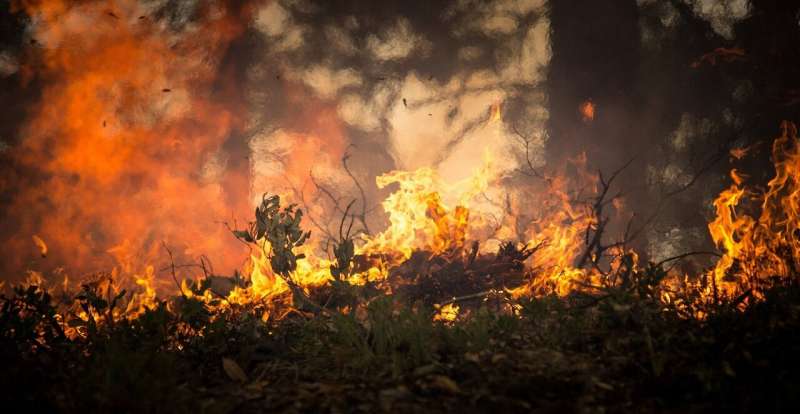Between wildfires, land in the US West has short 10- to 15-year reprieve

In the wake of a devastating wildfire, burnt land has a respite before the next blaze. But until now, no one has known just how long that effect lasted across the US West. Researchers from the University of Colorado Denver and Portland State looked into the increasing rates and intensity of fires in the U.S. West, like Colorado's Hayman Fire and California's Camp Fire, are up tenfold over the last 40 years. They wanted to know, once the shrubs, trees and other woody fuels have burned up, how long before the next one?
"We generally get about 10 to 15 years of 'protection' post burn, meaning a lower probability of reburning—not a long time," says Brian Buma, Ph.D., assistant professor in the Department of Integrative Biology at CU Denver. His work with CU Denver grad student Katherine Hayes, as well as Melissa Lucash, Ph.D., and Shelby Weiss of Portland State, found that the reburn effect is shorter in California and longer in the Rockies.
The study is published in the journal Environmental Research Letters.
Wetter locales see more wildfires
Reburning is incredibly impactful ecologically and can rapidly eliminate forests for the long term, as forest systems aren't generally resilient to high rates of high intensity fire. Logically, it seems like the increase in fires would eventually self-regulate; that an increase in fire rates could limit future fire occurrence—called a "negative feedback." Buma and his team found that this negative feedback and downtime between fires depended on climate, drought conditions, and the ecosystem type/fuel (read: trees, shrubs, grass).
Researchers used high spatial resolution satellites with over 30 years of burn data from the Monitoring Trends in Burn Severity database and drought magnitude data from the Standardized Precipitation-Evapotranspiration Index for the study.
In wildland forest locations, they found that drought-ridden and drier locales like Idaho and Colorado have longer stretches of post-burn protection (about 20 years) because the woody debris in those forests require extreme drought to carry fires and the land lacks grassy fuels.
Coastal California, however, receives more moisture and grassy fuel grows quickly, increasing the risk for reburn, seeing that negative feedback disappear after about 10 years.
"Because California is more open and more productive, it grows fuels back every year," said Buma. "Evidence shows that you can expect similar dynamics at lower elevation front range. Big fires in Colorado, for example, happen after wet years."
Fire suppression leads to more fire
The results are an important validation of small scale field studies scattered around the West, said Buma. They also serve as a warning to fire managers as to the limits of natural buffers against reburning, not to mention the importance of letting fires burn in the first place.
"We've been suppressing fires ever since the creation of Forest Service in the early 1900s," he said. "Then a series of fires in 1910 burned a huge amount of the Northern Rocky Mountains in what's called "The Big Burn." The fire footprint covered an area about twice the size of Connecticut, 3 million acres—about 22 times as large as the Hayman fire."
In the 1980s, the necessity of fires began to gain acceptance. But there's still a lot to learn. Prescribed burns and thinning practices can limit woody fuel and prevent widespread destruction like Colorado saw in 2002, when the Hayman Fire impacted more than 138,000 acres of the Colorado Front Range.
"Politicians and administration officials may not be aware that a forest that burned 20 years ago is no longer burned and perfectly primed to burn again," said Buma. "It's been 18 years since the Hayman Fire. Any negative feedback is now gone."
This study was funded by the National Science Foundation. Buma and his team will publish the underlying data, available in high spatial resolution, for researchers hoping to apply the findings or further dive into the history of reburning in their local areas.
More information: Brian Buma et al. Wildland fire reburning trends across the US West suggest only short-term negative feedback and differing climatic effects, Environmental Research Letters (2020). DOI: 10.1088/1748-9326/ab6c70
Journal information: Environmental Research Letters
Provided by University of Colorado Denver



















